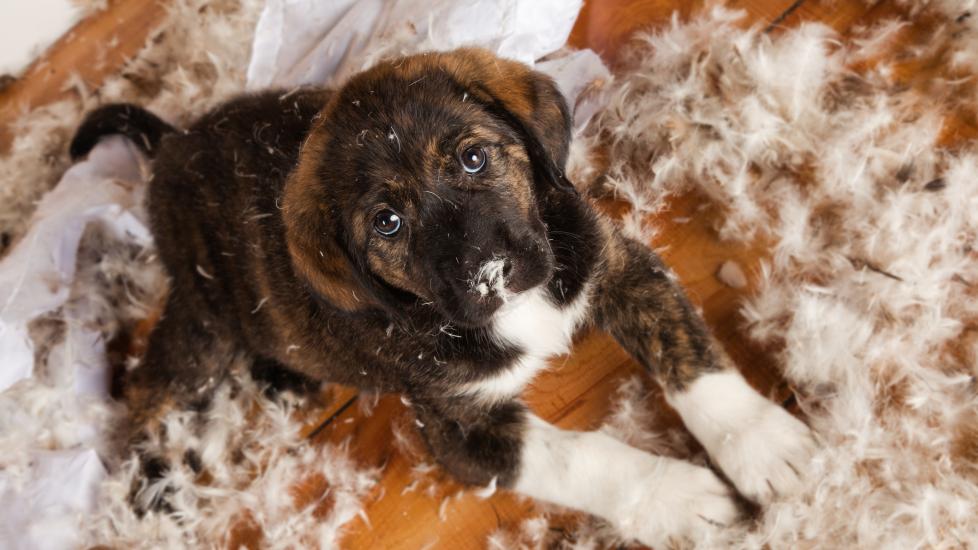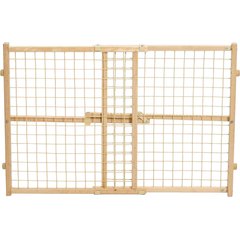How to Puppy-Proof Your House
Before you bring home a new puppy, make sure that your house is safe for them and protected from normal puppy behaviors.
This can prevent your dog from sniffing out trouble.
You can start puppy-proofing a house by walking around your home and outdoor space and imagining what a puppy could eat, climb up, squeeze through, get into, or pull down.
You may even want to crouch down so you can see your home from your puppy’s perspective and discover hidden dangers.
Anything you’d take away from a toddler, you should also keep out of your puppy’s reach.
Here’s a step-by-step checklist of what to secure in and around your home.
Puppy-Proofing Inside Your Home
First, let's look at tasks inside your house.
Lock Up the Trash Cans
Keep trash cans and diaper pails in closets or get securely locking lids or childproof latches. Trash cans contain plenty of food hazards for curious puppies.
Raisins, grapes, onions, garlic, chocolate, and other items that puppies might find in the garbage can be toxic to dogs. Even if they are not toxic, high-fat foods and food scraps can cause pancreatitis.
Watch out for any trash or recycling that might be strewn around the house, such as aluminum foil, plastic wrap, cans with sharp edges, and plastic canisters, which puppies can get their heads caught in.
Ingestion of these products may cause a bowel obstruction in dogs.
Store all food in cupboards, not out on kitchen counters.
Cover Electrical Wires and Outlets
Invest in covers for your outlets—puppies can lick these and end up seriously hurting themselves. You should also get covers to secure wires and strands of lights, especially around the holidays.
Puppies are known for chewing, so you will want to puppy-proof the wires in your home before your puppy can get their teeth near them.
Fish tank tubing is fairly chew-proof and works well to run electric cords through. Just make a slit in the tubing to pass the wire through.
Secure Heavy Furniture
Secure lamps, bookshelves, and decorations that a puppy can pull off or knock over. You can buy anti-tipping kits so you can anchor heavy furniture to the wall so they can’t be tipped over and harm your pet.
Tie Up Window Treatments
When puppy-proofing a house, think of more obscure risks, like your curtains. Low-hanging curtains can become a chewing target that puppies can pull on and potentially rip off the wall, so make sure they are secured, pulled to the side, and out of reach.
The cords for lifting and lowering your curtains can also be potential risks for your puppy. Puppies may chew the plastic or get tangled in the strings, which could lead to strangulation.
Evaluate Your Indoor Plants
While it is always nice to have some greenery in your home, consider which plants are safe for puppies. Some plants are toxic for dogs and can lead to serious health issues that require a visit to the vet.
No matter which plants you choose, to fully puppy-proof a house, keep them out of reach of your puppy. This will prevent them from chewing the plant itself or digging in the dirt.
Our vet team is here for all the new pet how-to’s and what if's.
Store Medications Safely
Puppies can easily chew up childproof lids and ingesting what’s inside. Move all human medications, prescription pet medication, and toiletries out of reach.
Puppy-Proof the Bathroom
Hygiene items found in bathroom trash cans be a hazard for puppies. Opt for a can with a locking lid or secure the lid with a childproof latch. Keep toilet lids down to prevent puppies from drinking from toilet bowls, as this poses health risks.
Keep Cleaning Supplies in Cabinets
Drain cleaners can be deadly if swallowed, and many other household cleaners are toxic.
Secure all cleaning supplies in cabinets and get cabinet locks if needed.
Do so even if you use products that are labeled as having natural ingredients—this is no guarantee that they are safe for pets, especially if ingested.
Block Off Cat Food Bowls and Litter Boxes
Make sure that your cat’s bowl, cat food bag, and litter box are out of reach. Most dogs can’t resist sampling cat droppings, which can lead to parasite transmission or obstructions from ingesting cat litter.
Move Small or Sharp Objects
Move any open storage containers—like baskets of craft supplies, coins, shoes, or toys—to a closed closet or on a high shelf.
Puppies, like babies, will explore everything and anything. Most commonly, they do so with their mouths. If it shouldn’t be tipped, flipped, licked, or chewed, it should be out of reach of the curious pup.
Set Up Dog Gates
Dog gates can be lifesavers for both you and the pup. They can be used to reduce the amount of space your puppy has access to, which translates to less space that you need to puppy-proof!
For example, limiting the new pup to a single room of the house means that you can eliminate puppy dangers from that small area, and then you can allow your new companion supervised space elsewhere.
Also, a smaller area will help potty train your new puppy.
Dog gates can also be used to block off stairs. Puppies are notoriously clumsy about stairs, and you don’t want your new pup to go head over tail down the full flight!
Secure Windows and Doors
Windows and doors can be major dangers for new puppies. They have no idea that an open window could lead to a 15-foot drop onto concrete.
They also don’t understand that screens are not firm barriers, and they may accidentally go charging through.
Most importantly, front doors lead to perhaps the most dangerous place for a pup—the street. Many dogs can learn how to open doors, so be sure that you have childproofing in place for your pup’s safety.
Puppy-Proofing Your Yard
The next area to tackle is your yard.
Check the Fence
While you should always supervise your puppy, it’s important to look for weak spots in your fence. You’d be surprised how little space they need to crawl out of a secure yard, and how quickly they are able to do so!
Put a Fence Around the Pool
Drowning is a real possibility, even if your puppy can swim.
Sometimes it only takes a drop in water levels of a few inches to make the difference between when a puppy can get out of a pool and when they can’t.
A young puppy may not know where the steps are yet or how to use them. The pool should always be a supervised place for your dog.
Secure Garage and Yard Supplies
Ingestion of antifreeze can be fatal, so lock it up and clean up spills using a clay-based litter or by thoroughly hosing the area down.
Any liquid you keep in the garage—whether it’s fuel or a household cleaner—is probably toxic to dogs (and cats).
Secure all heavy tools, and store small tools like screws and nails high off the ground.
Check for Toxic Flowers and Plants
You’ve already checked your house for dangerous plants, but don’t forget to check the yard, too! Most puppies will decide which plants and flowers they “like” by their taste. Some plants are extremely toxic, while others cause just irritation to the gastrointestinal tract.
Keep Your Puppy Safe From Fertilizer and Pesticides
Bug sprays, rat poison, fertilizer, and herbicides can be fatal if consumed. Don’t use them unless necessary. And if you do have any on the premises, make sure that they are properly stored.
Puppies love to chew on containers to make things come out—but if that thing is rat poison, it will also act as a dog poison.
Keep all of these hazardous products far out of reach of both puppies and children.
Set Up a Shady Rest Area
Puppies can get hot and tired quickly, and they don’t know when to slow down and rest.
Having a nice, comfortable area where you can sit and hang out with your pup will encourage them to rest when they need to.
Place a raised outdoor cot and an insulated water bowl with cool water in the spot to make it even more appealing.
Here are few products to keep your new puppy comfortable:
Supervise Your Puppy Outdoors
When supervising your puppy, consider them as you would a toddler.
You wouldn't let a toddler play in the yard alone, and your puppy shouldn’t be out alone either. Keep them on a leash if they aren't in a fenced-in area.
Cut the Grass Frequently
Lots of bugs that sting and bite can be found in long grass—everything from yellowjackets and hornets to fleas and ticks.
By keeping the grass short, it is easier to see exactly what your pup is getting into, and it will also discourage some insects from hanging around.
Featured Image: iStock.com/JulieWeiss




